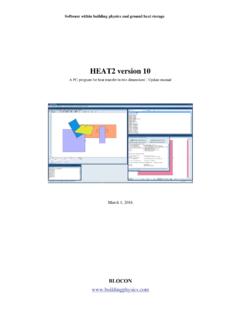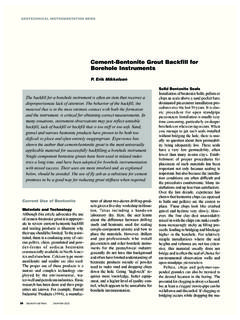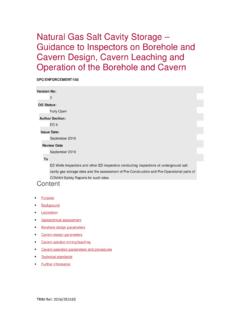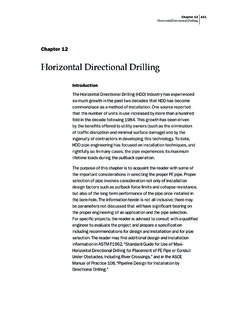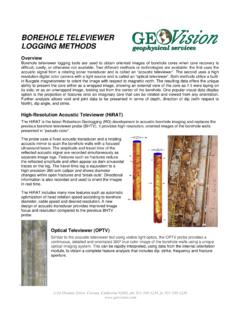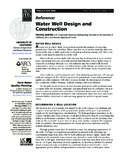Transcription of Earth Energy Designer - building physics
1 Software within building physics and ground heat storage BLOCON EED Earth Energy Designer February 19, 2015 2 Acknowledgements The development of the fundamentals for EED has been supported by the Swedish Council of building Research (Byggforskningsr det), Stockholm, and by the German Federal Ministry for Education, Science, Research and Technology (BMBF), Bonn. The responsibility for content and functioning of the program is with the authors only. The program implementation has partially been funded by the Wallenberg Foundation Fellowship Program in Environment and Sustainability by the Knut and Alice Wallenberg Foundation at Massachusetts Institute of Technology, Cambridge, USA. The following persons have been involved in the development of the EED program: Dr. Thomas Blomberg e-mail: Prof.
2 Johan Claesson Dept. of building physics , Chalmers University of Technology, SE-412 96 Gothenburg, Sweden, tel: +46-31-7721996, fax: +46-31-7721993, e-mail: Dr. Per Eskilson Dept. of Mathematical physics , Lund University, 118, SE-221 00 Lund, Sweden Dr. G ran Hellstr m Dept. of Mathematical physics , Lund University, 118, SE-221 00 Lund, Sweden, tel: +46-46-2229091, fax: +46-46-2224416, e-mail: Dr. Burkhard Sanner Asternweg 2, D-35633 Lahnau, Germany, tel: +49-6441-963416, fax: +49-6441-962526, e-mail: 3 Contents 1. INTRODUCTION .. 5 OVERVIEW .. 5 BACKGROUND OF EED .. 5 SYSTEM REQUIREMENTS AND INSTALLATION .. 5 DESCRIPTION OF FILES .. 6 IMPORTANT PROGRAM FEATURES .. 7 NEW FEATURES IN VERSION .. 7 UPDATE EED .. 8 DOCUMENTATION AND FREQUENTLY ASKED QUESTIONS (FAQ:S) .. 8 2.
3 EED MAIN MENU .. 9 INTRODUCTION .. 9 CREATING DEFAULT INPUT .. 10 OUTPUT FILES .. 10 3. DATA INPUT .. 11 GROUND PROPERTIES .. 11 borehole AND HEAT 14 borehole THERMAL RESISTANCE .. 20 HEAT CARRIER FLUID .. 21 INPUT OF BASE LOAD DATA .. 23 INPUT OF PEAK LOAD DATA .. 25 SIMULATION PERIOD .. 28 4. CALCULATION OF MEAN FLUID TEMPERATURE .. 29 5. OUTPUT OF RESULTS .. 31 INTRODUCTION .. 31 CHANGING CHART PROPERTIES .. 34 4 Introduction .. 34 Chart and series 35 6. CALCULATION OF REQUIRED borehole LENGTH FOR GIVEN FLUID TEMPERATURE CONSTRAINTS 37 7. OPTIMIZATION OF borehole LENGTH AND COST .. 41 8. COST DATA .. 42 9. CHANGE OF UNITS .. 43 10. MULTILINGUAL OPTION .. 47 INTRODUCTION .. 47 HOW TO CREATE FILES FOR A NEW LANGUAGE .. 47 11. UPDATE EED .. 49 INTRODUCTION .. 49 NEW LICENSE MANAGEMENT SYSTEM.
4 49 INSTALLATION TO NEW FOLDERS .. 49 EXPORT TO EXCEL IMPROVED .. 49 UPDATED LANGUAGE FILES .. 49 12. LITERATURE .. 51 APPENDIX A. OUTPUT DATA FILE .. 51 APPENDIX B. OUTPUT DATA FILE .. 60 APPENDIX C. DATA OUTPUT FILES.. 66 APPENDIX D. LIST OF POSSIBLE borehole CONFIGURATIONS.. 69 5 1. Introduction Overview Earth Energy Design (EED) is a PC-program for borehole heat exchanger design. Its ease of use, short learning curve, quick calculation times and inherent databases make it a useful tool in everyday engineering work for design of ground source heat pump system (GSHP) and borehole thermal storage. In very large and complex tasks EED allows for retrieving the approximate required size and layout before initiating more detailed analyses. Even for very small plants EED values the effort to do a calculation instead of using rules of thumb is worthwhile.
5 In ground source heat pump system, heat is extracted from the fluid in the ground connection by a geothermal heat pump and distributed to the building . The fluid is then re-warmed as it flows through the ground. In cooling mode, the process is reversed. This makes it a renewable, environmentally friendly Energy source. Background of EED PC-programs for quick and reasonably sound dimensioning of ground heat systems with vertical Earth heat exchangers have been presented by Claesson, Eskilson and Hellstr m, see list of literature in Section 0. Algorithms have been derived from modelling and parameter studies with a numerical simulation model (SBM) resulting in analytical solutions of the heat flow with several combinations for the borehole pattern and geometry (g-functions). Those g-functions depend on the spacing between the boreholes at the ground surface and the borehole depth.
6 In case of graded boreholes there is also a dependency on the tilt angle. The g-function values obtained from the numerical simulations have been stored in a data file, which is accessed for rapid retrieval of data by EED. Calculation of brine temperatures is done for monthly heat/cool loads. Databases provide the key ground parameters (thermal conductivity and specific heat) as well as properties of pipe materials and heat carrier fluids. The monthly average heating and cooling loads are the input data. In addition, an extra pulse for peak heat/cool loads over several hours can be considered at the end of each month. The user can choose between different methods of establishing a monthly load profile. A printed output report and output graphical processing are provided. The program has an easy-to-use interface.
7 The borehole thermal resistance is calculated in the program, using the borehole geometry, grouting material, pipe material and geometry. The borehole pattern may be chosen at will from a database of 798 basic configurations. System requirements and installation EED v3 is a software package running on Microsoft Vista/Windows 7 and 8. Program and databases require approximately 7 MB hard disk space. EED is delivered as a self-extracting file that installs the program and databases in a folder the user can choose. It will install the following files and a subdirectory named Projects where project data files may be stored. It may be a good idea to make further sub-folders for each major project. Also, the EED-icon will be added to the start menu of Windows. 6 Description of files Name Extension Content Programs and system files: EED exe Program file EED (executable) gfunc3 eed g-functions Databases: borediam txt borehole diameter cond txt Ground thermal conductivity fillcond txt Filling thermal conductivity gfunc txt List of g-functions hcdat txt Heat carrier fluids heatcap txt Ground specific heat heatflux txt Geothermal heat flow pipe txt Pipe material surftemp txt Ground surface temperature Language files txt See folder Languages Project data files have the extension.
8 Dat . Output files have the extension .out . Project data files can be saved under the File menu with the Save or Save as command: Output files are generated by EED with the name of the project data file, adding the extension .out . These files are written in ASCII-code and can be loaded by common text editors (correct display of columns is only achieved with rigid fonts like Courier, not with proportional fonts). The monthly temperatures in the output files are listed in columns and can, after preparation with a text editor, be loaded into graphic software. 7 The databases are ASCII-text files with the extension .txt and can be completed with additional data the user may have, or changed to meet user requirements (sufficient experience is vital!). Important program features Number of configurations EED version 3: 798 EED version 2: 308 Number of g-functions EED version 3: 6385 EED version 2: 2465 Types of borehole heat exchangers Coaxial pipes U-pipes (single, double, triple) borehole depth 20 - 200 m Ratio borehole spacing / borehole depth BH Time interval t = dimensionless time a = thermal diffusivity (m /s) 't with: ttts' and tHas 29 Short-time criterion E1 = exponential integral 05412.
9 Eratb Further details concerning the basic mathematical procedures used for the program can be found in the literature listed at the end of this manual, see Section 0. New features in version The main news of EED are as follows: Optimization that gives a list of best solutions for various parameters within specified ranges. Results may be exported to Excel file. Simple cost calculation. English units added. Easy conversion between SI and English units. Pc-program multilingual. New languages can be added. Currently: English, German, Swedish, French, Dutch, Italian, Hungarian. See for more languages. 8 More configurations with large systems (798 as compared with 308 in EED ). More G-functions (6385 as compared with 2465 in EED ). Improved accuracy (multipoles 1->10).
10 Improved convergence on borehole length. Hot water treated separately. Flow rate can be given for whole system. A default input file can be created. List of most recent input files. A lot of smaller improvements. Important notice for users of EED : G-function numbers larger than 241 has new numbers in EED 3 due to new configurations. The numbers are not the same as in EED 2. When an old (EED ) input file is read, the old G-func number will be remapped to the new definition. Note however that EED input files should not be used by EED or EED Update EED Please see chapter 11 for more info about this upgrade. Update info for new versions can also be found at Documentation and frequently asked questions (FAQ:s) Please see this page for more info : 9 2. EED main menu Introduction Figure shows the main menu: Figure : Main menu of EED.

